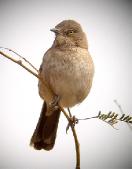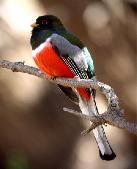|
| |||||||||||||||||
|
|
| ||||||||||||||||
 | ||||||||
 | ||||||||
BYLAWS | ||||||||
ARIZONA BIRD COMMITTEE BY-LAWS 2004
Part 1. NAME A. Name. The official name of this organization shall be the "Arizona Bird Committee" hereafter referred to as "A.B.C." Part 2. PURPOSES A. Validate records of selected birds from the State of Arizona, including, but not limited to, all such records submitted for publication to any official journal or checklist. B. Maintain permanently the original bird records and all Committee votes and comments for use by future bird students. C. Publish at least minimal data on all records receiving a decision. D. Provide a means by which sight records can gain universal acceptance as valuable scientific data. E. Increase knowledge of the birds of Arizona. F. Establish standards of observation and reporting against which field observers may compare their own techniques. G. Keep or cause to keep the official Arizona State Bird List. PART 3. COMMITTEE MEMBERS A. The committee shall consist of eight members. B. A member of the A.B.C. shall serve a four-year term beginning January 1 and ending December 31. C. After serving a four-year term, committee members will rotate off of the committee and must remain off of the committee for a period of at least one calendar year before he or she can be nominated for another four-year term. D. There is no limit to the number of four-year terms that an individual can serve. E. Each year two of the eight A.B.C. members will rotate off of the committee. These two will always be the two members with the most seniority. F. Each year two new members will be elected to the A.B.C., bringing the total number of committee members back to eight. PART 4. NOMINATION AND ELECTION OF COMMITTEE A. Election of new committee members will take place during the annual meeting of the A.B.C. B. Each committee member may nominate one person for membership on the A.B.C. This process will take place by mail or by phone at least 30 days prior to the annual meeting. Members shall nominate persons willing and able to serve on the A.B.C. C. The Secretary will compile the list of nominees and bring this list to the annual meeting. D. The merits of all the nominees will be discussed openly at the annual meeting of the A.B.C. E. If there are only two nominees, and these are acceptable to the existing committee, then these two nominees will automatically be elected to the A.B.C., and no vote is needed. F. If more than two candidates are nominated to fill the two vacant slots, then a vote is needed. This vote will be by secret ballot to the Secretary at the meeting. All committee members will vote for two new members, with the two highest vote getters elected to the committee. In the event of a tie, there will be a run-off election for those nominees that tied. PART 5. SECRETARY A. The secretary is appointed by the unanimous approval of the committee members. B. The secretary is eligible to serve an unlimited number of years. C. The secretary shall coordinate and maintain the circulation of bird reports among the committee members. D. The secretary shall organize and preside over an annual meeting. E. The secretary and/or any committee member shall prepare the reports of accepted and rejected records, and submit these reports for publication to Western Birds, or another appropriate journal if this journal is unavailable. The report shall be reviewed by the members of the A.B.C. before it is submitted for publication. F. The secretary shall inform the person submitting a record, by postcard, that the record has been officially submitted to the A.B.C. If that record is ultimately accepted by the A.B.C., the secretary will then notify the observer, again by postcard, that the record has been accepted by the A.B.C. G. The secretary shall keep a file including copies of all records that have been considered by the A.B.C. PART 6. VOTING ON RECORDS A. Committee members will vote on each record being circulated around the committee. The secretary will circulate packets of records to the committee members until each record is voted on be each committee member. B. A record is accepted by the A.B.C. if the record receives unanimous approval or one dissenting vote. C. If a record receives two or more negative votes, it is rejected by the committee. D. A record that receives two or more "dissenting" votes will be recirculated around the committee for a second round of voting. This is to insure that every committee member has the opportunity to view all of the comments, particularly on controversial records, and then have the opportunity to vote again. If after the second round a record still has two or more negative votes, then it is rejected by the committee. E. Committee members will record their votes on the separate recording sheet that will accompany each record. Each committee member is encouraged to vote "yes" or "no" for each record. In the past, members have voted "pass" when they have felt that they had insufficient personal experience with a particular species. In the future, committee members are encouraged to "research" the identification of a species if they have little experience with it, and then vote "yes" or "no". Committee members are also encouraged to include at least brief comments along with their vote, particularly on records that they vote "no" on. These comments will be valuable if and when a record is recirculated. Obviously, not all records require lengthy comments, but there has been a trend in recent years to not include any comments at all. F. Each committee member is encouraged to vote on a batch of records within three weeks (and if possible sooner) upon receiving that packet. After completing a packet, each committee member is asked to mail that packet to the next committee member on the list provided. The last committee member voting on a packet shall return that packet to the secretary.
| ||||||||